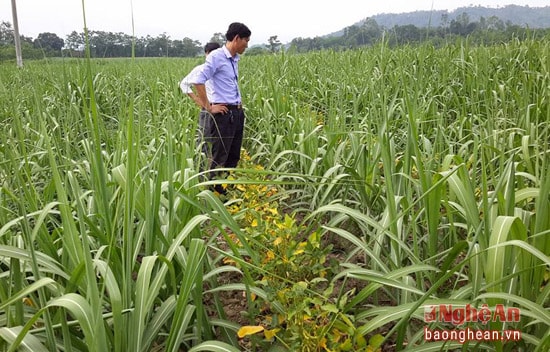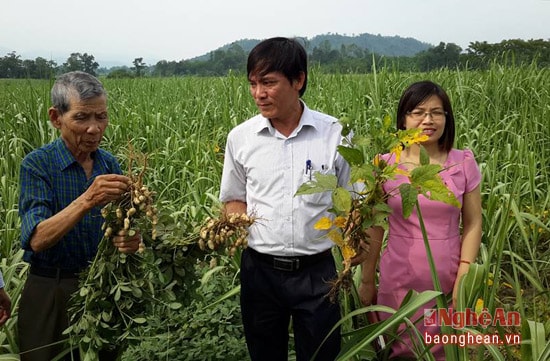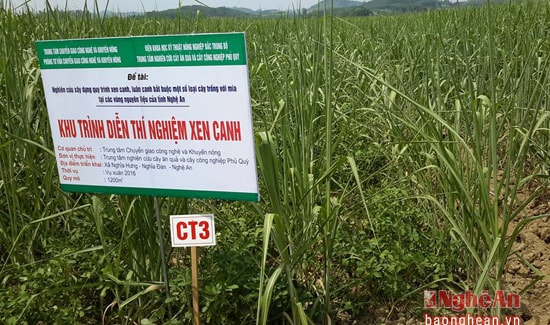Intercropping beans and peanuts to prevent weedy shoot disease in sugarcane
(Baonghean.vn) - People in Nghia Hung commune, Nghia Dan district (Nghe An) have a creative way of intercropping beans and peanuts on sugarcane land.This method brings positive results, helping people harvest dozens of tons of beans and peanuts each year, while also helping to prevent drought in sugarcane and grass shoot disease.
 |
| The model of intercropping beans between sugarcane in Nghia Hung helps control weeds and avoids wasting land when the sugarcane has not sprouted or is still short. Photo by Tran Quoc Thanh |
After harvesting sugarcane, from January to February, people take advantage of the empty space between rows of sugarcane to plant legumes such as green beans, black beans, and peanuts.
The advantage of this method is that people do not have to fertilize beans and peanuts because they inherit fertilizer from sugarcane and do not have to weed sugarcane because the bean and peanut canes cover the sugarcane rows. Moreover, it also limits weed disease, especially when planting in rotation.
The time to plant beans and peanuts is from January to February at the same time as planting spring sugarcane and harvesting sugarcane. After 2.5 to 3 months, beans and peanuts are ready to harvest, with an average yield of 10 to 15 quintals per hectare. After deducting expenses, people earn 12 to 15 million VND.
Mr. Hoa Van Luc, hamlet 6, Nghia Hung commune, grows 5 sao of beans mixed with sugarcane every year. In addition to the income from sugarcane, he also earns an additional 5 million from black beans. Mr. Luc shared: Growing beans in sugarcane requires less care, the soil moisture is higher, and the sugarcane yield is higher. After harvesting the bean stems and leaves, they are also used as fertilizer for the sugarcane. Therefore, every year, after the sugarcane harvest, or when planting new sugarcane, the family plows the land to plant beans in the sugarcane.
Because of this double benefit, many sugarcane growing households in Nghia Hung actively plant beans on sugarcane land.
Mr. Nguyen Hong Truong - Hamlet 10, Nghia Hung Commune, one of the first people to plant beans intercropped with sugarcane, added: Each hectare of beans intercropped with sugarcane can yield 10 quintals, and does not require much care. In addition, planting beans and peanuts intercropped with sugarcane is also a way for people to prevent drought for sugarcane because legumes help maintain moisture and nitrogen in the soil.
Mr. Phan Phuc Vinh - Chairman of Nghia Hung Commune People's Committee said: In addition to income from beans, the productivity of sugarcane intercropped with beans is 5 to 7 quintals/ha higher. Calculating from planting sugarcane and beans on a unit area, it brings in more than 10 million VND/ha of income compared to monoculture sugarcane. Currently, Nghia Hung commune grows over 35 hectares of beans each year. The commune will continue to replicate and maintain this model to help farmers increase income and improve the land.
 |
| Leaders of Nghe An Department of Science and Technology check the effectiveness of growing peanuts in sugarcane. |
From the model of Nghia Hung, people in some communes such as Nghia An, Nghia Khanh, Nghia Duc… also learned the experience of intercropping legumes on sugarcane land to increase income and improve the soil.
Phu Qui Fruit and Industrial Tree Research Center also conducted a model of growing beans and peanuts in sugarcane in Nghia Hung and found it very effective, providing a basis for people to expand the area.
 |
| Agricultural extension units and the Bean Institute implement models for people to follow. |
Mr. Tran Quoc Thanh - Director of the Department of Science and Technology of the province said: This is a simple and effective scientific application model. Peanut rotation yields over 3 tons/ha, intercropping yields 2 tons/ha, black beans yield 1.5 tons/ha, soybeans yield 1 ton/ha. The model is valuable in limiting grass shoot disease when implementing rotation.
Dinh Thuy
